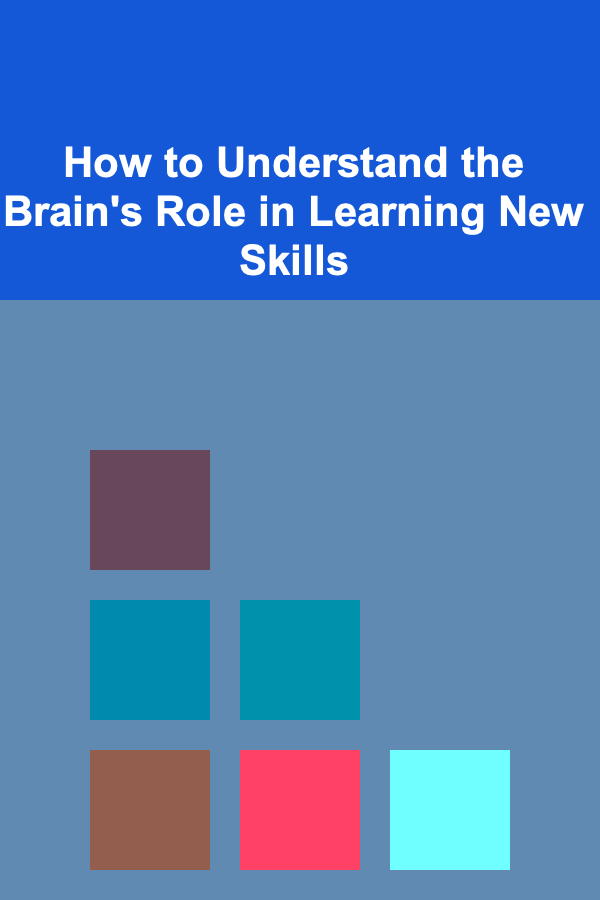
How to Understand the Brain's Role in Learning New Skills
ebook include PDF & Audio bundle (Micro Guide)
$12.99$7.99
Limited Time Offer! Order within the next:

Learning new skills is a fascinating and complex process, one that engages many aspects of the brain's structure and function. From the initial exposure to a new task to the mastery of that skill, our brain undergoes a variety of changes that enable us to adapt, refine, and perform the skill with increasing efficiency. Understanding how the brain facilitates this process can give us insights into optimizing our learning experiences and improving our ability to acquire new skills.
In this article, we will explore how the brain plays a central role in learning new skills, the key areas involved, and the processes that take place during skill acquisition. We will also examine some strategies to enhance learning by tapping into the brain's natural mechanisms.
The Basics of Skill Learning
Skill learning can be defined as the process through which an individual acquires the ability to perform tasks effectively and efficiently. Skills can range from simple actions, like tying a shoe, to more complex abilities such as playing a musical instrument or speaking a new language.
When you attempt a new skill, the brain processes the task by activating certain regions involved in motor control, sensory processing, memory, and decision-making. Over time, with repeated practice and feedback, these regions communicate and adapt, strengthening the neural connections required to perform the skill automatically.
The concept of "neuroplasticity" lies at the heart of this process. Neuroplasticity is the brain's ability to reorganize itself by forming new neural connections. This phenomenon allows the brain to adjust its structure and function in response to new learning experiences.
Key Brain Regions Involved in Learning New Skills
The brain is made up of specialized areas that work together to process the information required to learn a new skill. Understanding these regions can help us appreciate how the brain supports skill acquisition.
1. Motor Cortex
The motor cortex plays a central role in the execution of voluntary movements. It is divided into two primary regions: the primary motor cortex and the premotor cortex.
- Primary Motor Cortex: Located in the frontal lobe, the primary motor cortex is responsible for controlling specific muscle groups in the body. As you practice a new skill, this region becomes more active, fine-tuning the movements required for the task.
- Premotor Cortex: This region is involved in planning and coordinating movements before they occur. When learning a skill, the premotor cortex helps you develop a mental blueprint of how the movements should unfold.
2. Basal Ganglia
The basal ganglia are a group of nuclei deep within the brain that are crucial for motor control, habit formation, and procedural learning. This region plays a critical role in automating movements. Over time, as you practice a skill, the basal ganglia help you perform actions with less conscious effort, turning them into habits or "muscle memory."
The basal ganglia's involvement in skill learning becomes particularly evident in activities such as playing a musical instrument or typing. The more you practice, the more the task becomes automatic, allowing you to perform it with minimal conscious thought.
3. Cerebellum
The cerebellum, located at the back of the brain, is involved in fine-tuning motor control and coordination. It ensures that movements are smooth, accurate, and well-timed. When learning a new skill, the cerebellum is essential for improving motor precision and synchronizing movements.
In activities such as sports, dancing, or playing an instrument, the cerebellum is critical for adjusting and refining movements based on feedback. It helps you correct errors in real time, allowing for continuous improvement as you practice.
4. Prefrontal Cortex
The prefrontal cortex, located in the frontal lobe, is involved in higher cognitive functions such as decision-making, attention, and working memory. This region helps you focus on the task at hand, plan the steps needed to execute a skill, and adjust your approach as you receive feedback.
The prefrontal cortex is particularly important in the early stages of skill learning when conscious effort and attention are required. As you progress, however, the reliance on the prefrontal cortex decreases, and the task becomes more automatic, engaging other brain areas such as the motor cortex and basal ganglia.
5. Hippocampus
The hippocampus, part of the limbic system, is critical for forming new memories. In the context of skill learning, the hippocampus helps store and recall information related to the task, enabling you to remember the steps and sequences required to perform it.
Research suggests that the hippocampus plays a more prominent role during the initial stages of learning when you need to consciously recall instructions or guidelines. As the skill becomes more ingrained, the hippocampus' involvement decreases, and the basal ganglia and cerebellum take over the automation of the task.
6. Sensory Areas of the Brain
The sensory cortex processes input from the senses, including touch, sight, and hearing. For many skills, sensory input is crucial to learning. For example, when playing the piano, the brain processes tactile feedback from your fingers, auditory feedback from the sound of the keys, and visual feedback from the sheet music or keyboard.
In skills that involve precise movements or detailed feedback, the sensory cortex and other sensory areas of the brain play an essential role in adjusting and refining movements over time.
The Role of Feedback in Skill Acquisition
Feedback is a fundamental component of skill learning. Whether it comes from external sources (e.g., a coach or teacher) or internal sources (e.g., self-perception of performance), feedback helps you identify mistakes and correct them, facilitating progress in skill acquisition.
1. Error Detection and Correction
The brain constantly evaluates your performance and compares it to the desired outcome. The basal ganglia and cerebellum are particularly involved in error detection and correction, allowing you to adjust your movements in real-time.
For example, when learning to ride a bicycle, your brain detects small errors in balance and makes automatic corrections to prevent falls. With repeated practice, these corrections become more refined, and your ability to balance improves.
2. Intrinsic vs. Extrinsic Feedback
- Intrinsic Feedback: This is feedback that comes from within, such as the feeling of a muscle contracting or the sensation of hitting the right note on a piano. Intrinsic feedback is vital for learning because it allows the brain to adjust movements based on personal experience.
- Extrinsic Feedback: This feedback comes from external sources, such as a coach's instructions or a score on a test. Extrinsic feedback can provide additional information that the brain may not immediately pick up, guiding further refinement of the skill.
Balancing intrinsic and extrinsic feedback is key to efficient learning. Too much external feedback can overwhelm the learner, while too little can result in slower progress.
The Importance of Repetition and Practice
Practice is critical for skill acquisition because it strengthens neural connections and reinforces learning. When you repeatedly engage in a task, your brain forms and refines the pathways necessary for performing that task.
1. The Role of Synaptic Plasticity
Synaptic plasticity refers to the process through which neural connections are strengthened or weakened based on activity. Repeated practice causes synapses to become stronger, facilitating faster communication between neurons. This is why repetition is essential in learning any new skill.
For example, when learning to play a musical instrument, the brain's motor and sensory areas strengthen their connections with each practice session, allowing you to play more fluidly and accurately.
2. Deliberate Practice
Deliberate practice involves focused, goal-directed practice with the aim of improving specific aspects of a skill. Unlike casual practice, deliberate practice requires conscious effort, consistent feedback, and frequent adjustments to technique. Research has shown that deliberate practice is the most effective way to improve performance in complex skills.
For example, professional athletes, musicians, and chess players all engage in deliberate practice to refine their skills. They break down tasks into smaller components, focus on areas of weakness, and receive continuous feedback to enhance their performance.
3. The Role of Sleep in Skill Learning
Sleep plays a vital role in consolidating new skills. During sleep, the brain processes and consolidates memories formed throughout the day, reinforcing the neural pathways associated with skill learning. This is why sleep is often referred to as the "secret ingredient" for enhancing performance.
Research suggests that sleep, particularly deep sleep and REM sleep, is crucial for consolidating motor skills and integrating new information. This explains why practicing a skill before going to bed can often lead to improved performance the next day.
Enhancing Skill Learning Through Neuroscience
Understanding how the brain learns new skills opens the door to optimizing the learning process. Several strategies, rooted in neuroscience, can help you accelerate skill acquisition and enhance your learning experience.
1. Challenge Yourself with New and Complex Tasks
To encourage neuroplasticity and promote skill development, it's important to challenge yourself with tasks that require mental and physical effort. The brain thrives when faced with novel and complex problems, which help strengthen neural connections and improve cognitive function.
2. Use Visualization Techniques
Visualization is a powerful tool for learning new skills. Research shows that imagining performing a skill can activate the same neural pathways as actually performing the task. By visualizing the movements and the desired outcome, you can reinforce the neural circuits involved in that skill.
3. Vary Your Practice Routine
Varied practice is more effective than repetitive, monotone practice. Mixing up the environment, the type of tasks, and the speed at which you perform the skill can create more robust neural connections and improve retention. This type of "variable practice" challenges the brain and promotes deeper learning.
4. Stay Consistent with Practice and Feedback
Consistency is key to skill development. Make practice a regular habit and seek constant feedback to refine your performance. By integrating consistent practice with both intrinsic and extrinsic feedback, you can accelerate the learning process and make it more efficient.
Conclusion
The process of learning new skills is a deeply intricate interaction between the brain's structure, function, and plasticity. From the motor cortex's control of movement to the basal ganglia's facilitation of automaticity, each part of the brain plays a vital role in transforming a novice into an expert. By leveraging the principles of neuroplasticity, repetition, feedback, and focused practice, we can optimize our learning experiences and accelerate our mastery of new skills. The brain is a remarkable organ that continuously adapts to help us grow, learn, and succeed. Understanding this process empowers us to make the most of our cognitive abilities and achieve our goals.

How to Market Rental Properties to Attract the Right Tenants: An Actionable Guide
Read More
How to Turn Your Bathroom into a Spa-Like Retreat on a Budget
Read More
How to Use Magnetic Strips for Storing Hooks
Read More
Philosophy of Language: Analyzing the Nature and Function of Language
Read More
How To Build a Strong Content Governance Plan
Read More
How to Reconcile Retirement Distributions with Your Tax Returns
Read MoreOther Products

How to Market Rental Properties to Attract the Right Tenants: An Actionable Guide
Read More
How to Turn Your Bathroom into a Spa-Like Retreat on a Budget
Read More
How to Use Magnetic Strips for Storing Hooks
Read More
Philosophy of Language: Analyzing the Nature and Function of Language
Read More
How To Build a Strong Content Governance Plan
Read More